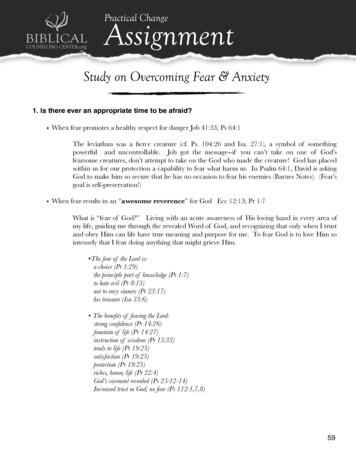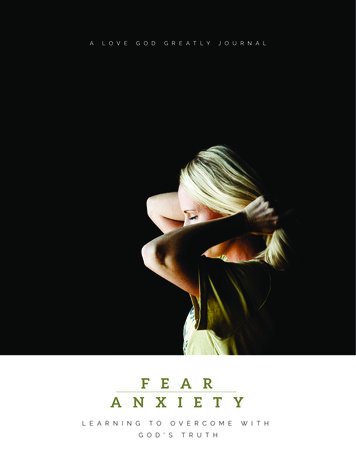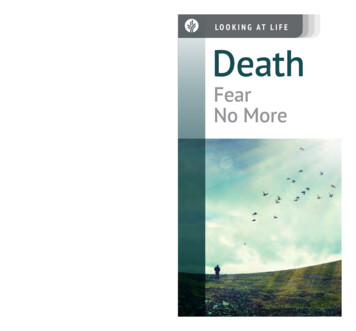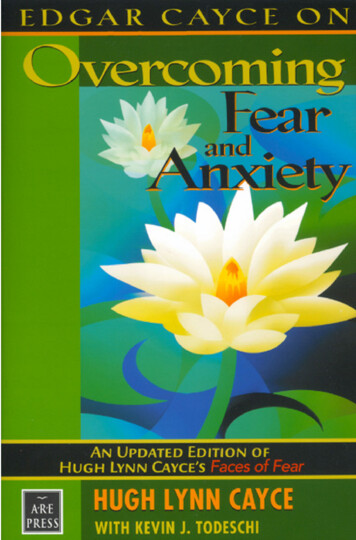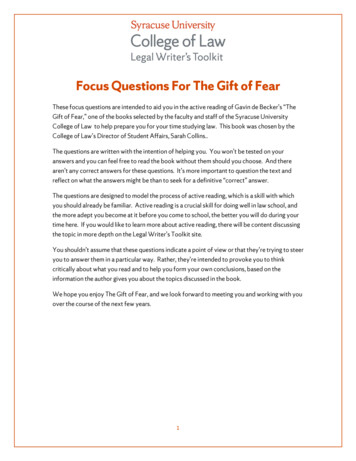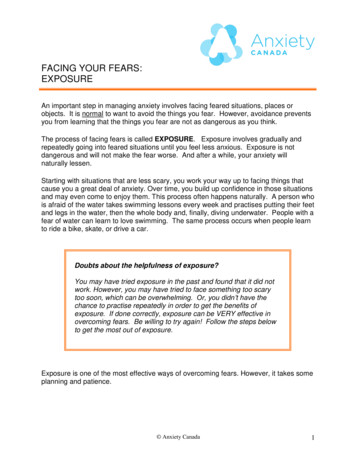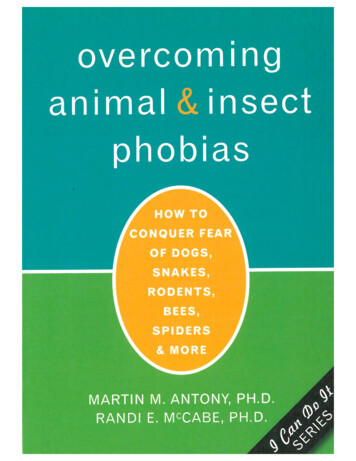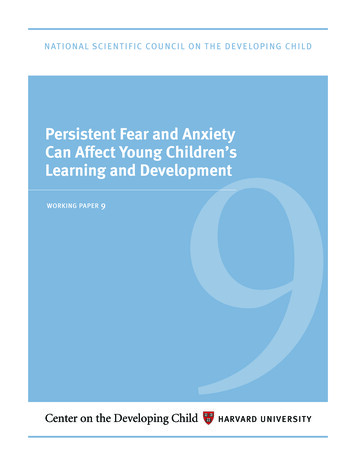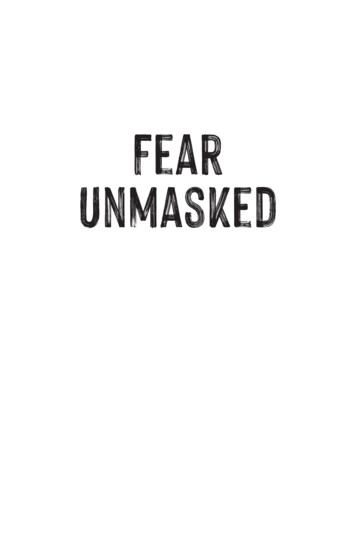
Transcription
FearUnmasked
FearUnmaskedDI S C OV E R I NG T H E T RU T H OFT H E C OR ONAV I RU S SH U T D OW NCl ay Cl ar k
Copyright 2020 by Clay Clark.All rights reserved. No part of this publication may be reproduced,distributed, or transmitted in any form or by any means, includingphotocopying, recording, or other electronic or mechanical methods,without the prior written permission of the publisher, except in thecase of brief quotations embodied in critical reviews and certain othernoncommercial uses permitted by copyright law. For permissionrequests, write to the publisher at the address below.Fedd BooksP.O. Box 341973Austin, TX 78734www.thefeddagency.comPublished in association with The Fedd Agency, Inc., a literary agency.Unless otherwise noted, all scripture quotations are taken from aretaken from The Living Bible (TLB) copyright 1971 by Tyndale HouseFoundation. Used by permission of Tyndale House Publishers Inc.,Carol Stream, Illinois 60188. All rights reserved. The Living Bible, TLB,and the The Living Bible logo are registered trademarks of TyndaleHouse Publishers.ISBN: 978-1-949784-45-9eISBN: 978-1-949784-46-6Printed in the United States of AmericaFirst Edition 15 14 13 12 11 / 10 9 8 7 6 5 4 3 2
TABLE OF CONTENTSINTRODUCTION.71.2.3.4.5.6.7.8.9.10.The Boy Who Cried Wolf. 17Fear Unchecked by Facts. 25Who Is Actually at Risk?. 33Is This Pandemic Truly “Unprecedented”?. 45A Reason for Hope. 53The Winners and Losers of the Shutdown. 59A Cure Worse than the Problem . 71When It Became Unethical to Go to Work . 79The Root of the Problem . 97The Cure for Fear. 103CONCLUSION. 115APPENDIX A. 125Guide for Small Business Owners: How to GetMoney Back into Your HandsAPPENDIX B . 13110 Quarantine Jokes That Will Help You Forgetthe Fact That You Are Stuck at Home
INTRODUCTION“Education is the key to unlock the golden doorto freedom.”– George Washington CarverClose your eyes and picture for a moment a place andtime where America has completely stopped. Ouronce bustling streets are now empty. The Starbucksdrive-through no longer has the standard ten-minuteline wrapped around it, and Chick-fil-A is no longerpacked Monday through Saturday. Picture a weirdparallel universe where the streets of Los Angeles haveno traffic and the only drama being reported aboutthe NCAA’s March Madness is that it was cancelled.Visualize walking through the nearly always, twentyfour-hour energetic and urgent Times Squarewithout running into a single person (other than theoccasional police officer who has been assigned to goout patrolling to make sure that you are not violatingever-changing protocol).Unless you have been living under a rock, youcannot help but to see and hear the fear-inducingcoronavirus updates relentlessly reigning down
FEAR UNMASKEDupon you. It’s confusing, unprecedented (you’veprobably heard that word a hundred times in thelast week), and it seems like no one really knowswhat’s going on. Yesterday you heard that 2.2 millionbeloved Americans are predicted to die from thecontagious coronavirus, but today you heard thatless than 200,000 Americans are predicted to die.Should you be worried or should you be relieved?Things change every day and it seems that no oneknows what is going on.As I drove to the gas station yesterday to fill upmy wife’s suburban with unleaded gas that is nowat the coronavirus-caused-low-low-price of 1.56per gallon, I could sense panic and fear everywhere.The man filling up his large Ford F-350 withgasoline was wearing a mask, and the streets wereeerily empty. In fact, the people who were actuallydesperate enough to go out and buy the food andgoods they needed were going in and out of the gasstation while practicing “social distancing,” so it wasawkward to watch them walk past each other whiletrying to avoid one another while still being kind.Since mid-March of 2020, our federal and localgovernments have been pushing us, pleading withus, and mandating us to help stop the spread of thevirus with the same intensity and focus that I usedto employ as a kid to avoid physical contact with the8
I ntroductioncute girls in the first grade because of the “cooties”virus that I knew all girls had.Even as I briefly isolated myself from humanityto write this book, I cannot escape the fear-inducingmessages being pitched at me from every direction.Even now, when I sit down in my “Man-Cave” to writethis book about the coronavirus, I do what I alwaysdo when I write a book, I shut the door and preparefor uninterrupted focus on the research and writingtask at hand. However, this time, when I turn on theorchestral Beautiful Mind soundtrack on Spotify,my focus is constantly being interrupted by Spotifyletting me know of what steps they, as a company, aretaking to combat the spread of the coronavirus.During the past thirty days, as I have beenresearching and gathering the data for this book, Ihave been relentlessly interrupted by CNN, Fox News,Google, YouTube, Facebook, Spotify, the WeatherChannel, that one store that I bought socks fromonce, and nearly every other business and platformwith a relentless reminder of the dangers of thecoronavirus pandemic. And when those platformsare not reminding me to be worried and to live infear, the physical billboards that I see around townin route to the grocery store remind me to “WASHHANDS OFTEN WITH SOAP AND WATER FORAT LEAST TWENTY SECONDS” to prevent the9
FEAR UNMASKEDspread of COVID-19.However, I can sincerely tell you that after Iinvested the 100-plus hours of time needed to gatherthe facts to write this book, I no longer experience anyfeelings of fear when I am interrupted by or alertedto the BREAKING NEWS related to the spread ofCOVID-19, which is why I am writing this book. Iam writing this book so that YOU will no longer livein the perpetual fear caused by being pelted with anunrelenting barrage of social media posts, alarmistmedia headlines, and the rumors of somebody youknow who knew somebody else who knew somebodywho died as a result of “getting the coronavirus.”Whether it is right-wing media, left-wing media, oryour social media that is fueling the flames of fear, Iknow that many people, and even potentially you, arecurrently living in a constant state of fear. This book isgoing to provide you with the facts and informationyou need to be empowered to act as needed and toleave behind the emotions of fear that have preceded.I’m going to cite stats for you, and I hope yourealize EVERYTHING is cited with the “crediblemedia sources” that also incite fear. The same mediaoutlets feeding you the fear are also providing enoughfactual stats if you read between the lines. However, ifyou only actually read the headline of an article, youmight miss that part.10
I ntroductionIdleness truly is the devil’s workshop, and manyquarantined Americans are idle right now and areunsure of what to do with their down time. So, forthe same reasons people like gossip and spreadingrumors in the office break room, people who are nowstuck at home are simply spewing their fact-free fearson Facebook and other social media platforms for allof the world to see. Whether it be for reasons that areeither conscious or subconscious, many Americansare trying to pass the time by writing increasinglyalarming posts which leads to more shares, onlinedebates, and “social interacting” during this time of“social distancing” and “emotional distancing.”Ironically, in this world of constant digitalconnectivity, people were already feeling lonelier andmore isolated than ever, even before the coronaviruspanic. Think about the last time you went to arestaurant before the coronavirus shut most of themdown. Were the people at the restaurant looking ateach other or their smartphones? The start of beingphysically present but completely mentally absentbegan with the omnipresence of your smartphone.1Nielsen reports that now the “average” person isspending 11.3 hours per day consuming media.2 Theability for fear to be spread virally via smartphonesis new to us all. Consider this: in 2009, the “swineflu” infected 60.8 million American people and11
FEAR UNMASKEDkilled 12,469, but it did not cause the widespreadpanic and complete government shutdown ofAmerica.3 Why? And why don’t most people evenremember the “swine flu” outbreak? Social mediaand smartphones were relatively new at the time ofthe outbreak, and I think this played a huge part inthe lack of general hysteria.I am writing this book for you, because as ahusband, a father of five kids, an owner of multiplebusinesses, and the host of the chart-toppingThrivetime Show business podcast, I have literallyinteracted with thousands of people just like youover the phone, via email, and through social mediawho have become paralyzed by the fear caused by notknowing the facts related to the coronavirus panic.As I’ve lived my life, I’ve found that logic-killing fearis often related to not knowing the truth about thedangers we all face. In 1992, the NBA superstar basketball playerKarl Malone refused to play basketball on thesame basketball court as Magic Johnson forFEAR of getting HIV.The famous Greek philosopher Socrates wassentenced to death by hemlock poisoningin 399 B.C. for questioning the merits of theprevalent religion of the time for FEAR that12
I ntroduction he would corrupt the youth and cause an endof the world as the Greeks knew it.Jesus was convicted of treason and wascrucified at just the age of thirty-three forFEAR that he and his message would destroythe Roman empire.Many people ignorantly supported legalsegregation for FEAR that African Americanswould take jobs from non-African Americansand would ruin American life as they knew it.FEAR is an unpleasant emotion that is caused bybelieving that the future is going to be worse thantoday, and something or someone is a direct threatto you or has the ability to hurt you. Fear kills joy,extinguishes hope, and reduces your ability to thinklogically. When you are wondering if a serial killer isin your basement, it makes it hard to sleep. When youare wondering if you forgot to turn off your oven, it’sreally hard to enjoy your beachside tropical vacation.When there is fear, there is no peace.Now, before we go any further, I do have to makea big ask from you. Yes, I realize that we’ve just met,but could I have your undivided attention for thenext two hours please? Pretend that reading thisbook is like going to your favorite theater (beforethe quarantine began) and you are being asked to13
FEAR UNMASKEDturn your phone off or at least turn your phone ontoairplane mode as you watch that feature presentation.I promise if you will give me two hours of yourtime, I will give you some much-needed peace,hope, and maybe even joy as you realize how bad thecoronavirus is and isn’t. Throughout the course of thisbook, I promise that I will provide you the followingpanic-killing and fear-reducing benefits: You will no longer worry about who the viruscan kill (because you will have the facts).You will no longer worry about the economicfall-out related to the coronavirus (becauseyou will know the details related to ourgovernment’s response).You will no longer feel the need to glue yourface to your devices, sifting through thedoomsday headlines and political agendas ofeither party to find the facts that you and yourfamily need to be safe during this “weird time.”You will no longer feel the need to debatewith the soul-sucking, fear-mongering, endtimes-prepping people on social media.You will find yourself 100 percent uninterestedin going down the Google search black-hole ofrun-away conspiracy-theory research.You will take advantage of this downtime and14
I ntroductionyou will start crossing things off of your to-dolist that you’ve been putting off because youpreviously “didn’t have the time.”Recently, I interviewed Patrick J. McGinnis, whois a successful venture capitalist and the creator ofthe word FOMO, which stands for “Fear of MissingOut.” Long before this coronavirus panic, the “Fearof Missing Out” became a HUGE problem for peoplein this world. It is a big part of the reason why weare addicted to our smartphones; we don’t want tomiss anything. Psychology Today now reports thatthe average person is interrupted over 100 times perday with smartphone notifications.4 That’s a lot ofinterruptions. So, while I do understand that just theact of turning off your smartphone long enough toinvest the two hours needed to learn everything youneed to know about COVID-19 could cause you toexperience fear, I think it will cause less fear in thelong run as we dismantle the panic surrounding thecoronavirus.You might be thinking: But what if I miss “the bigcall?” What if I miss the “big news update?” Whatif the supplier of the custom Darth Vader mask Iordered to protect myself from the coronavirus callsme to confirm my hat size? My friend, to make thisdeal fair, I promise you that I am going to write you15
FEAR UNMASKEDone hell of a book that is filled with everything, andonly everything, that you and your family will needto be able to live without fear during the time of thisworld-wide coronavirus panic.16
CHAPTER 1THE B OY WHO CRIED WOLF“If you tell a big enough lie and tell it frequently enough,it will be believed.”– Adolf Hitler“Fear is the mind-killer.” – Elon MuskHow did we get into this situation? In late 2019, theworld was introduced to a new version of an olddisease, the coronavirus, or COVID-19 as it has cometo be known. In the phrase COVID-19, the ‘CO’stands for ‘corona,’ the ‘VI’ stands for ‘virus,’ and the‘D’ stands for disease and 19 refers to the year it wasrecorded to have started. Whether it is coronavirus4, coronavirus 8 or coronavirus 19, coronavirusescome from a large family of viruses that are commonin people and many different species of animals,including camels, cattle, cats, and bats. While there
FEAR UNMASKEDhas been debate over how this disease originated,we know COVID-19 originated in China, and for awhile, it was little more than a story with few detailsreported infrequently by the mainstream media.However, as America was going about its businessand growing the economy at a record-setting rate,Neil Ferguson—the director of the Abdul LatifJameel Institute for Disease and Emergency Analytics(J-IDEA), the head of the Department of InfectiousDisease Epidemiology in the School of Public Health,and the Vice-Dean for Academic Development in theFaculty of Medicine, all at Imperial College, London—released a projection in February 2020 that wouldbecome the FEAR fuel that coronavirus pandemicpanic needed to go viral on social media and traditionalmedia. Neil Ferguson projected that 500,000 citizens ofthe United Kingdom population would die from thisnew disease and that the United States alone wouldexperience a shocking 2.2 million deaths.Once the world began to learn of Neil Ferguson’spredictions, the right-wing and left-wing mediafanned the flames of fear related to the pandemicpanic and these headlines then turned into an all-outdumpster fire of panic as people began sharing thesefears, and doomsday predictions on their personalsocial media accounts. Because the average personnow spends over eleven hours a day consuming18
T he B o y W ho C ried W o l fmedia on their smartphones, it only took hours forthis coronavirus story to grow dangerously viral.Quickly, people began to hoard toilet paper andessential food items in preparation for the “worstcase scenarios” presented by Neil Ferguson. Why wastoilet paper hoarded? Does the coronavirus causediarrhea? No. But as a general rule, fear and panickills humanity’s ability to think critically. Try havinga rational phone conversation with somebody whilethey are sprinting for their life in Spain’s Running ofthe Bulls; it won’t go well. Try teaching somebodyabout the merits of abstinence while they are currentlyengaged in having sex; it won’t go well.Without really knowing how the coronaviruswould impact the amount of deaths in our country,our elected officials decided to let the fear of theunknown dictate their actions, beginning with Dr.Deborah Birx. Dr. Birx is the Coronavirus ResponseCoordinator for the White House Coronavirus TaskForce; she is the one who called for the President to“shut it down.”The Governor or New York, Andrew Cuomothen stated during a press conference, “What we didwas . . . we closed everything down. That was ourpublic health strategy. Just close everything down.If you rethought that or had time to analyze thatpublic health strategy, I don’t know that you would19
FEAR UNMASKEDsay quarantine everyone . . . I don’t even know thatthat was the best public health policy. Young peoplethen quarantined with older people was probably notthe best public health strategy because the youngerpeople could have been exposing the older people toan infection . . .” 5Self-quarantining and shelter in place becamemandatory and immediately Americans had all losttheir constitutional rights to peaceably assemble inorder to “keep you safe from the coronavirus.” Tomake your life 3 percent easier, I have included theFirst Amendment from that controversial documentthat millions of brave men and women have foughtto protect since September 17, 1787, “Congress shallmake no law respecting an establishment of religion,or prohibiting the free exercise thereof; or abridgingthe freedom of speech, or of the press; or the right ofthe people peaceably to assemble, and to petition thegovernment for a redress of grievances.”All of sudden, church congregations were notallowed to peaceably assemble, most Americans wereforced to stay home and non-essential businesseswere forced to close in order to “keep you safe.” Instates like Oklahoma, abortion clinics, liquor stores,and marijuana dispensaries were deemed to be“essential,” while hair salons, retail stores, and otherbusinesses were deemed to be “non-essential.” Now,20
T he B o y W ho C ried W o l fmany Americans are forced to “stay at home” andwait indefinitely for this virus to run its course.In Proverbs 16:27-29 the text reads, “Idle handsare the devil’s workshop; idle lips are his mouthpiece.An evil man sows strife; gossip separates the bestof friends. Wickedness loves company—and leadsothers into sin” (TLB). And that is exactly what idleAmericans are doing. In fact, Newsweek reportedthat US alcohol sales increased by 55 percent in justone week amid the coronavirus pandemic lockdown.6And US News reported that the coronaviruspandemic has boosted marijuana sales while manybusinesses that are forced to be closed are struggling.7And when Americans are not out busy increasingtheir consumption of alcohol and marijuana, manyhave decided to invest their “free time,” to post theirpontifications about the coronavirus. In our digitalworld, it literally became impossible to turn on anymedia-serving device without being bombarded bythe panic-filled headlines.Only after things got out of hand and panicbecame the default setting of Americans everywheredid Neil Ferguson update his predictions. Neiladjusted his projections to predict that thecoronavirus will cause 20,000 United Kingdomdeaths, which means that Neil’s early predictionswere twenty-five times too high.8 Oops. Ferguson’s21
FEAR UNMASKEDlatest prediction of 20,000 United Kingdom deathsimplicates that America should likely expect 88,000deaths caused by the coronavirus—not 2.2 milliondeaths. To put this in perspective, America lost80,000 people from the common flu in 2017-2018,and that number includes 180 children according tothe Center for Disease Control.9Let’s take a moment to take in some facts. Thecoronavirus is twenty-five times less deadly thanNeil Ferguson originally predicted. And accordingto University of California Berkeley EpidemiologistDr. Arthur Reingold, “Children don’t get very sickwhen they get the coronavirus . . . If they developany symptoms at all they are mild, so severe illnessesand death are incredibly rare.”10 And according to thereports published by CNN, out of 731 confirmed and1,412 suspected cases of COVID-19 in children inChina, one child, a fourteen-year-old boy, died.11 Wenow also know that 99 percent of those who actuallydied from the coronavirus in Italy were elderly andalready had compromised immune systems.12Since this “pandemic” began, I have receiveddozens of text messages, breaking news alerts, andemails full of COVID-19 propaganda. And I’ve talkedto many frightened friends and family memberswho all believed that the end of the world is near; Ican’t even have a conversation them on a daily basis22
T he B o y W ho C ried W o l fbecause fear is ruining their ability to think rationally.President Franklin D. Roosevelt once famouslysaid, “Only thing we have to fear is fear itself,” and intoday’s current crisis he could not be more correct.However, I think his quote can only be outdone byBenjamin Franklin’s famous quote, “Those whowould give up essential Liberty, to purchase a littletemporary Safety, deserve neither Liberty nor Safety.”23
CHAPTER 2FEAR UNCHECKEDBY FACTSBecause of the fear-mongering media, and thegrossly overestimated reports from our good friendNeil Ferguson, we shut down our economy andforced “non-essential” businesses to shut their doors.This was a grave mistake (no pun intended) and thenumbers below show why our leaders should have keptthe world open for business. The only reason why ourleaders closed the world was because of sheer publicpanic resulting from inflammatory, misleading,and alarmist reports by news organizations, as wellas misinformation in the communications of ourcountry’s leadership with the public.At the time President Trump issued the socialdistancing and other guidelines (March 16, 2020),the worst widely reported case for shutting the worlddown was the fear that there would be an estimated
FEAR UNMASKEDand predicted 510,000 deaths in the UK and someestimated and predicted 2.2 million deaths in theUnited States, as detailed in a report by the ImperialCollege. But we should ask ourselves, even if thathappened, should the country shut down?Fear unchecked by facts—that’s the only reasonwhy the country shut down. According to the CDC’sdata from 2017, one person dies every six secondsfrom the top ten leading causes of death.13 Whetherfrom heart disease, traffic accidents, medicalmalpractice, on average, 5,703 people die every day.This was all before the coronavirus, and irrespective ofthe coronavirus, we do not shut down local, citywide,regional, national, international, or world economiesbecause of it. There is no reason to kill our economyby shutting it down solely based on these fears.Why didn’t our fearless leaders convey thesefacts while communicating with the public? Thisis unchecked sensationalism comes with a realconsequence: trillions of dollars in damages lost bysmall businesses and trillions of dollars in stimulusby the US government,14 which already has 23trillion in debt which grows by the second.15 Notcompelling? How about those killing themselvesexceeding coronavirus death rates in some places.16The fact is, there are different numbers, projections,click-bait stories, and “expert” opinions being shared26
Fear U nchec k ed b y Fact severy single day. The whiplash of the media andgovernment is disorienting, and all the confusioncauses more fear. Fear of the unknown, fear of leavingthe house, fear of going back to work.Here is a brief timeline of the coronavirus“pandemic” to show just how much things can changefrom one day to the next. Different leaders and expertsare saying different things and giving misleadinginformation, which is causing Americans to suffer.February 25, 2020An expert in disease research said don’t shut downthe world for a virus.“I don’t think the answer is shutting down the worldto stop this virus. It’s already out,” said MichaelOsterholm, director of the University of Minnesota’sCenter for Infectious Disease Research and Policy.Later in the article, Mr. Osterholm said: “trying tostop influenza-like transmission is like trying to stopthe wind. It’s virtually impossible . . .”17March 13, 2020Epidemic experts predicted that up to 1.7 million USresidents could die.The New York Times reported that officials from theCenters for Disease Control and Prevention andepidemic experts from around the world had gathered27
FEAR UNMASKEDon a conference call the previous month to exploreworst-case scenarios for the coronavirus’ toll.18 TheCDC modeled four scenarios and estimated that200,000 to 1.7 million US residents could die.19March 16, 2020The White House task force started issuing socialdistancing guidelines.Birx herself referenced the British report at acoronavirus task force press briefing, where theTrump administration announced that it would issuemore restrictive social distancing guidelines. Birx saidthe White House task force recommended limitinggatherings to fewer than ten people, consistent withthe British report made public that same day. 20March 19, 2020The “shelter in place” orders start.First in California, the government ordered residentsto stay at home unless absolutely necessary (to go tothe grocery store and other “essential” errands). Thenmore states follow suit.21March 24, 2020President Trump says we should never turn thecountry off.President Trump says: “Well, you have to make the28
Fear U nchec k ed b y Fact sdecision. Look, we lose thousands—I brought somenumbers here. We lose thousands and thousands ofpeople a year to the flu. We don’t turn the countryoff—I mean, every year. Now, when I heard thenumber—you know we average 37,000 people a year.Can you believe that? And actually, this year we’rehaving a bad flu season. But we lose thousands ofpeople a year to the flu. We never turn the country off.We lose much more than that to automobile accidents.We didn’t call up the automobile companies and say,‘Stop making cars. We don’t want any cars anymore.’We have to get back to work.”22March 26, 2020The director of NIAID says overall consequences ofCOVID-19 will be akin to the flu.Fauci writes in the New England Journal of Medicine,“If one assumes that the number of asymptomaticor minimally symptomatic cases is several timesas high as the number of reported cases, the casefatality rate may be considerably less than 1%. Thissuggests that the overall clinical consequences ofCOVID-19 may ultimately be more akin to those ofa severe seasonal influenza (which has a case fatalityrate of approximately 0.1%) or a pandemic influenza(similar to those in 1957 and 1968) rather than adisease similar to SARS or MERS, which have had29
FEAR UNMASKEDcase fatality rates of 9 to 10% and 36%, respectively.”23March 30, 2020Trump has a “change of heart” and decides to keepcontainment measures in place.The New York Times reported, “The president’s reversalon restoring normal life by Easter came as pollingshowed that voters overwhelmingly preferred to keepcontainment measures in place over sending peopleback to work prematurely.” President Trump “wasstruck by the political surveying that indicated that thepublic wanted the restrictions to continue long enoughto beat back the virus for fear that letting up too soonwould simply reinvigorate the outbreak.”24***The honest truth is that the media and our leadersmake matters worse by issuing misleading reports.With different reports and changes being made everyday, it is hard to keep up with and concerning that noone seems to know what’s going on. While headlinesmay be true and facts reported by the media maybe true, they do not always tell the whole story,which puts the country at large into a panic, and theworld economies at risk. Check out a few of theseinflammatory headlines. When read out of context,30
Fear U nchec k ed b y Fact sthese headlines leave readers panic-stricken. Why?Because a simple fact is missing: people in the USare dying at a rate of one person every six secondsanyway, regardless of the coronavirus. It’s all relative! NY Post headline: “Coronavirus killingpeople in New York City at rate of one every17 minutes”25Today.com headline: “Number of UScoronavirus deaths now exceeds 9/11 deathtoll”26Foxnews.com headline: White Houseprojects 100K to 240K coronavirus deaths asTrump tells US to prepare for ‘very painfultwo weeks’27Fear and panic are contagious. And the media isspreading fear to everyone. These headlines aren’tcommunicating the facts; they’re instilling fear. Nowthat you have seen the progression of the fear andpanic that was created by the media, we need to askourselves a very important question. That question is“who is the coronavirus killing”?31
CHAPTER 3WHO IS ACTUALLY AT RISK?As we take a look around at our country, we can clearlysee that there is panic everywhere. From young to old,sick to healthy, there is a lot of widespread fear. I was atWalmart picking up several necessities this morning,and most of the people around me looked like theywere doctors heading in for surgery. They had gloves,facemasks, and were sterilizing their grocery carts,literally from top to bottom. As we funneled intothe store, everyone was looking around nervously,staying at least six feet away from one another. I wasdressed in my standard clothing, absent gloves, afacemask, or any form of Lysol cleaner. You wouldhave thought that I was the one that was dressed upfunny. You should have seen the way that everyonelooked at me—lots of judgement was passed.What they probably didn
orchestral Beautiful Mind soundtrack on Spotify, my focus is constantly being interrupted by Spotify letting me know of what steps they, as a company, are taking to combat the spread of the coronavirus. During the past thirty days, as I have been researching and gathering the data for this book

